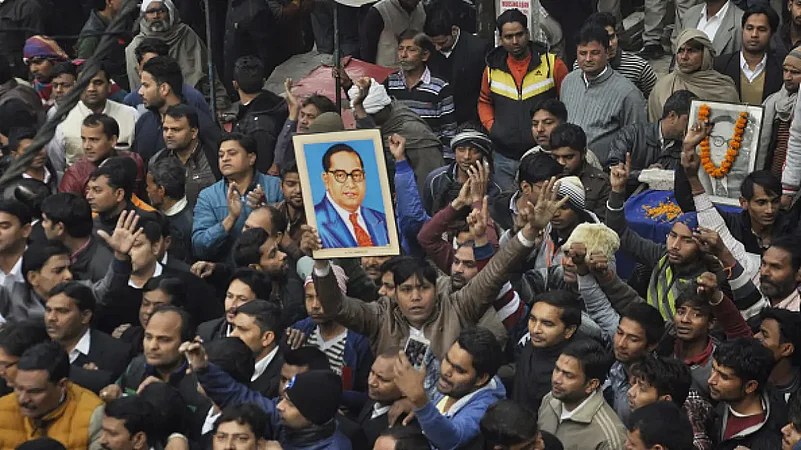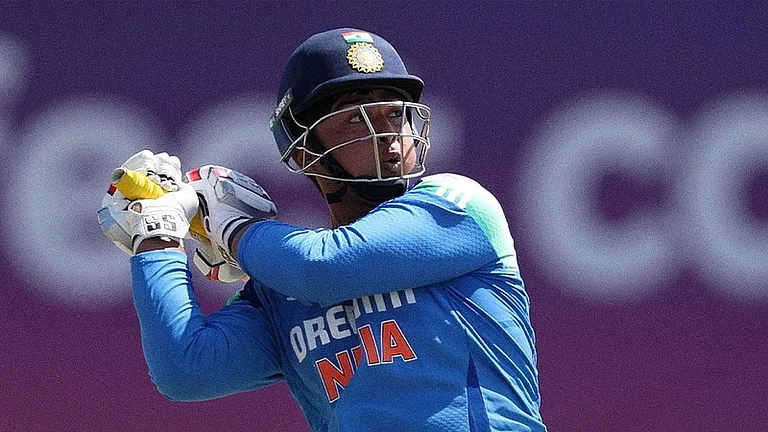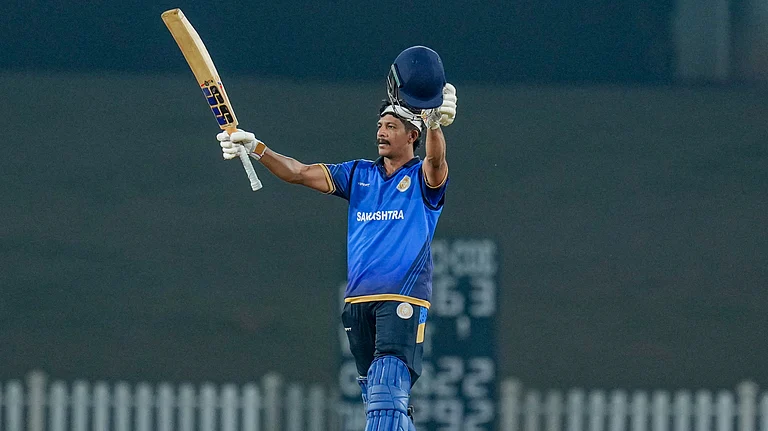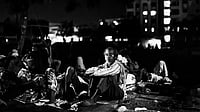Chulha mitti ka
Mitti Talaab ki
Talaab Thakur Ka
Bhukh Roti Ki
Roti Bajre Ki
Bajra Khet Ka
Khet Thakur Ka
Bail Thakur Ka
Hal Thakur Ka
Hal Ki Mooth Par Hatheli Apni
Fasal Thakur Ka
Kuan Thakur Ka
Pani Thakur Ka
Khet-Khalihan Thakur Ke
Galli-Muhalle Thakur Ke
Phir Apna Kya?
Gaon?
Shehar?
Desh?
(The stove is made out of mud
The mud is sourced from the lake
The lake belongs to the landlord
[We have] A hunger for bread
Bread made of pearl millet
Pearl millet grown in the fields
The field belongs to the landlord
The bull belongs to the landlord
The plough belongs to the landlord
The hands on the shaft of the plough are ours
The harvest belongs to the landlord
The well belongs to the landlord
The water belongs to the landlord
The crops and the fields belong to the landlord
The lanes that run through these neighborhoods belong to the landlord
Then what is ours [for Dalits]?
The village?
The city?
The nation?)
— A poem by Omprakash Valmiki
The pertinent questions raised in the painful poem of eminent Hindi literary writer Omprakash Valmiki have yet to find the answer as after 75 years, India's independent Dalits are still experiencing caste atrocities, violence, discrimination, and social exclusion.
Every 10 minutes, a Dalit faces a crime, according to National Crime Record Bureau (NCRB) 2020 report. Compared to the previous year, crime against Dalits rose by 9.4 per cent. Uttar Pradesh, one of India's populous states, has reported the highest number of atrocities against Dalits. Last month, a nine-year-old Dalit boy in Rajasthan was brutally beaten by his schoolteacher because he drank water from a pot meant for the upper caste. He later died. This is neither the first time nor the last when the upper castes’ purity, ego, and pseudo pride hurt. Their arrogance and caste superiority are often threatened when they find Dalits keeping moustaches, Dalit grooms riding horses, and using Ambedkarite songs as ringtones.
India is celebrating its 75th Independence Day — Azadi ka Amrit Mahotsav— but yet 'freedom from caste and caste-based atrocities' are a dream for India's nearly 20 per cent population, who are Dalits. In the pretext of India’s 75th Independence Day, the country must answer the questions Omprakash Valmiki raises — “What is ours (of Dalits)? The village? The city? The nation?” Besides, the country shall also introspect the contemporary situation of Dalits in society, economy, and polity.
According to the socio-economic and caste census 2011, 54.71 per cent of Dalit households are landless and they depend on casual labour for survival. The land is a significant resource with economic and social relevance as many find it a source of prestige and honour, particularly in villages. More than half of Dalit households are landless, which denies them economic benefits and excludes them from dignified treatment in villages. Census 2011 reported that nearly 69 per cent of the agricultural labourers are Dalits; their landlessness is one of the significant reasons to remain agricultural labourers. Their landlessness and engagement as agricultural labour certainly provoke knowing who has the major share of landholdings. And why? Such land-hold inequality exists because of caste and caste privilege, where one social group owns most of the resources, and others are denied.
When we are celebrating the national event Har Ghar tiranga¬ — Azadi Ka Amrit Mahotsav, many Dalit presidents (pradhan/mukhiya) of local governance have not been allowed to hoist the national flag in the panchayat office for many years. The recent report of The Tamil Nadu Untouchability Eradication Front (TNUEF) stated that in 20 village panchayats of Tamil Nadu, Dalit presidents were not allowed to hoist the national flag, 22 panchayats did not allow them to sit on the chair, and 42 panchayats did not allow them to have a name board in the panchayat office.
While looking at the discrimination and exclusion of the elected Dalit presidents in the panchayat, one can imagine the life of a common Dalit in the country. Besides this, Dalit women presidents often experience caste and gender-based discrimination in the panchayat office, which certainly highlights their vulnerable position in society due to the intersection of caste and gender. Just a couple of years back, in Tamil Nadu, a Dalit women panchayat president was denied seating on a chair and was forced to sit on the office floor while other panchayat members were sitting on the chair.
Dr BR Ambedkar urged Dalits to leave villages and migrate to cities to escape caste and caste-based prejudices for the annihilation of caste and freedom from caste. However, many Dalits migrated to the cities not merely to escape from caste but also to earn better living standards. Many of them could escape from caste to a limited extent, but in terms of getting better living standards, many are still struggling in the city. They are engaged in the informal sector of work in the city and they live in slums that lack basic facilities such as water, toilet, proper drainage, and cleanliness.
According to the census 2011, Dalits alone constitute more than 12 per cent of the urban population and share a dispropionate ratio of slum population which resulted in exclusion from safe housing and access to a toilet in the cities. However, despite sharing a disproportionate slum population, Dalits find the city a promising space that holds the promise of upward mobility for people belonging to the socially backward groups in village society. However, at the same time, they are also deprived of basic facilities such as water, toilet, housing, and cleanliness facility. Though most Dalit migrants are bound to live in slum areas of the cities but they are free from caste-based discrimination — if not completely, then at least to some extent. However, the larger question of resource ownership, inequality, exclusionary spatial, and urban marginalisation remain unanswered.
This inequality is visible in representation and disproportionate share in the government mechanism and system, highlighting the monopoly and hegemony of a social group —upper caste— over others. All India Survey for Higher Education (AISHE) reported that 8.6 per cent of teachers are Dalits, while the majority —58.8 per cent— are from the unreserved category. Against the 15 per cent quota for representation, Dalits are merely 8.6 per cent which certainly highlights the existing inequality in India's higher education. Such underrepresentation of Dalits in educational institutions is one example of existing inequality within the system, whereby many other government departments also have similar underrepresentation phenomena. Even after 75 years of independence, caste-based inequality, discrimination, and exclusion prevails in almost every sphere of society.
When I come across any news of caste violence and killing of Dalits because of mere riding a horse in marriage or drinking water from a pot meant for upper caste, keeping songs of Ambedkar as a ringtone, demanding wages, or any other reason for their killing, I remember words of Dr. Ambedkar to Mahatma Gandhi that “Gandhiji, I have no homeland…How can I call this land my own homeland and this religion my own, wherein we are treated worse than cats and dogs, wherein we cannot get water to drink?…If in my endeavour to secure human rights for my people, who have been trampled upon in this country for ages, I do any disservice to this country, it would not be a sin”.
Later also, in the last Constituent Assembly debate, Dr. Ambedkar expressed his apprehension about caste violence, discrimination, and exclusion of Dalits that "...we are going to enter into a life of contradictions. In politics we will have equality and in social and economic life we will have inequality. In politics we will be recognising the principle of one man one vote and one value. In our social and economic life, we shall, by reason of our social and economic structure, continue to deny the principle of one man one value...". His apprehension repeatedly becomes true whenever there is violence, exclusion, and discrimination with Dalits on the mere basis of 'caste'.
On the 75th Independence Day, the country must revisit Dr. Ambedkar's apprehension about the contradictory world in economic and social life, which may indeed provide the answers to Omprakash Valmiki's poem — “What is ours [for Dalits]? The village? The city? The nation?” That will not merely gain the faith of Dalits in the nation but also drive the country on a path and direction to accomplish the dream of freedom fighters what they had envisaged for us and the country.
(Ajeet Kumar Pankaj is an assistant professor at the Indira Gandhi National Tribal University’s regional campus in Manipur.)























